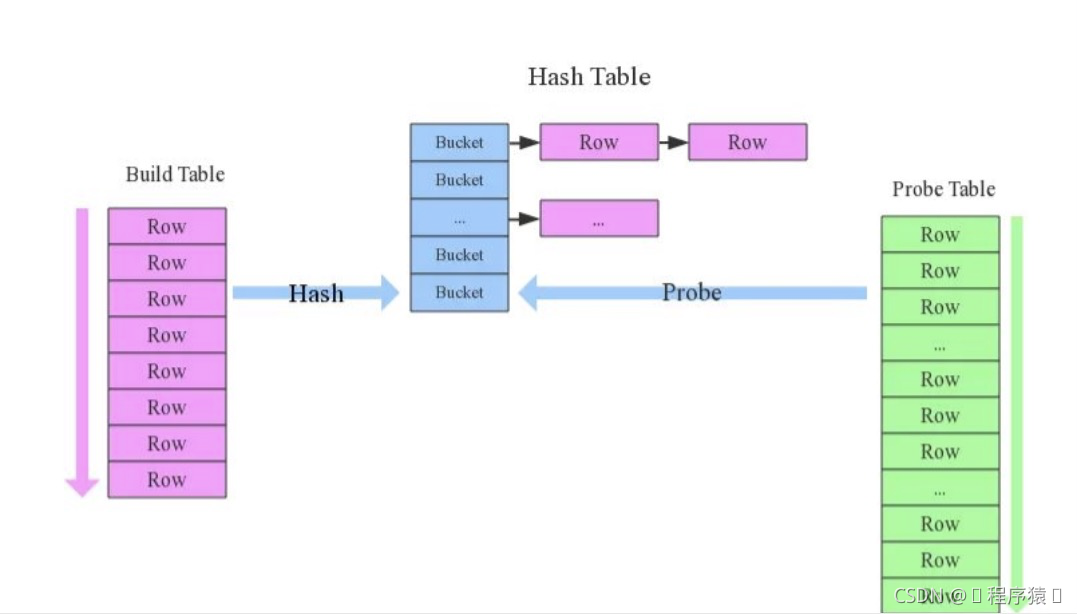简介
作为一个数据开发工程师,hive sql是我们必备的技能,好的hql语句让我们事半功倍。
列裁剪
所谓列裁剪就是在查询时只读取需要的列。以我们的日历记录表为例:
#错误示范
select
*
from user_info
where age = 18
#正确示范
select
uid
,uname
,sex
from user_info
where age = 18
当列很多时,如果select * ,全列扫描效率很低。
建议:不要图省事select *,应该进行列剪裁。
分区裁剪
所谓分区裁剪就是在查询时只读取需要的分区。以我们的日历记录表为例:
#错误示范
select
uid
,uname
,sex
from user_info
where age = 18
#正确示范
select
uid
,uname
,sex
from user_info
where dt_ymd >= '20190201'
and dt_ymd <= '20190224'
and age = 18
当数据量很大时,如果不指定分区,全表扫描效率很低。
建议:按照时间分区的hive表,查询时要加上时间限制,默认从所有数据进行遍历。
不使用distinct
所谓distinct就是在查询时对相应字段数据进行去重。以我们的日历记录表为例:
#错误示范
select
distinct uid
,uname
,sex
from user_info
#正确示范
select
uid
,uname
,sex
from user_info
group by uid
,uname
,sex
当数据量很大时,如果使用distinct,效率很低。
建议:用group by替代。
尽早过滤
所谓尽早过滤,就是在提前查询对数据集筛选过滤,减少数据量。以我们的日历记录表为例:
#错误示范
select
user_id
,uid
,uname
,sex
from user_info t1
left join
orer_info t2 on t1.user_id = t2.user_id
where t1.age = 18
#正确示范
select
uid
,uname
,sex
from
(select user_id,uid,uname,sex from user_info where age = 18)t1
left join
orer_info t2 on t1.user_id = t2.user_id
insert into代替union all
#错误示范
insert overwtite table xxxx
select a, b, c from table1
union all
select d, e, f from table2
union all
select h, i, j from table3
#正确示范 1
drop table if exists table xxxx;
insert into table xxxx
select a, b, c from table1;
insert into table xxxx
select d, e, f from table2;
insert into table xxxx
select h, i, j from table3;
#正确示范 2
insert into table xxxx1
select a, b, c from table1;
insert into table xxxx2
select d, e, f from table2;
insert into table xxxx3
select h, i, j from table3;
insert overwtite table xxxx
select a, b, c from xxxx1
union all
select d, e, f from xxxx2
union all
select h, i, j from xxxx3
union all替代join
#错误示范
select
ep.productid
,productname
,count(st.tduserid)
,count(distinct sl.tduserid)
,count(distinct sn.tduserid)
,avg(sl.interval_level)
from(select
productid
,productname
from xxx.product
where productid = '3006090'
) ep
join(select
tduserid
,productid
from xxx_page_ex
where l_date <= '2019-04-07'
and l_date >= date_add('2019-04-07', -6)
) st
on ep.productid=st.productid
join(select
tduserid
,interval_level
,productid
from xxx_launch_ex
where l_date <= '2019-04-07'
and l_date >= date_add('2019-04-07', -6)
) sl
on st.productid=sl.productid
join(select
tduserid
,productid
from xxx_newuser_ex
where l_date <= '2019-04-07'
and l_date >= date_add('2019-04-07', -6)
) sn
on sl.productid=sn.productid
group by ep.productid
,productname
;
刚开始然后写出的hql语句基本没啥优化,然后在生产集群跑了20分钟没跑完。用union all只跑了1m26s,写起来可能复杂些,不多说代码如下:
#正确示范
select
'2019-04-07' dates,
'3006090' productid,
max(pro) productname,
sum(pv) pv,
sum(uv) uv,
cast(sum(duration) as decimal(10,4)) duration,
sum(new_uv) new_uv
from
(select productname pro,
'0' pv,
'0' uv,
'0' duration,
'0' new_uv
from xxx.product where productid = '3006090'
union all
select '0' pro,
count(tduserid) pv,
'0' uv,
'0' duration,
'0' new_uv
from xxx_page_ex
where l_date <= '2019-04-07'
and l_date >= date_add('2019-04-07', -6)
and productid = '3006090'
union all
select '0' pro,
'0' pv,
count(distinct tduserid) uv,
avg(interval_level) duration,
'0' new_uv
from xxx_launch_ex
where l_date <= '2019-04-07'
and l_date >= date_add('2019-04-07', -6)
and productid = '3006090'
union all
select '0' pro,
'0' pv,
'0' uv,
'0' duration,
count(distinct tduserid) new_uv
from xxx_newuser_ex
where l_date <= '2019-04-07'
and l_date >= date_add('2019-04-07', -6)
and productid = '3006090'
) t;
那么数值的可以用sum求和,当有汉字时怎么办呢,用max就可以解决这个问题。
join基础优化
join优化是一个复杂的话题,下面先说5点最基本的注意事项。
build table(小表)前置
在最常见的hash join方法中,一般总有一张相对小的表和一张相对大的表,小表叫build table,大表叫probe table。如下图所示。

Hive在解析带join的SQL语句时,会默认将最后一个表作为probe table,将前面的表作为build table并试图将它们读进内存。如果表顺序写反,probe table在前面,引发OOM的风险就高了。
在维度建模数据仓库中,事实表就是probe table,维度表就是build table。假设现在要将日历记录事实表和记录项编码维度表来join:
#错误写法
select a.event_type,a.event_code,a.event_desc,b.upload_time
from (
select event_type,upload_time from calendar_record_log
where pt_date = 20190225
) a
inner join
calendar_event_code b
on a.event_type = b.event_type;
#正确写法
select a.event_type,a.event_code,a.event_desc,b.upload_time
from calendar_event_code a
inner join (
select event_type,upload_time from calendar_record_log
where pt_date = 20190225
) b on a.event_type = b.event_type;
多表join时key相同
这种情况会将多个join合并为一个MR job来处理,例如:
错误写法
select a.event_type,a.event_code,a.event_desc,b.upload_time
from calendar_event_code a
inner join (
select event_type,upload_time from calendar_record_log
where pt_date = 20190225
) b on a.event_type = b.event_type
inner join (
select event_type,event_code,upload_time from calendar_record_log_2
where pt_date = 20190225
) c on a.event_code = c.event_code;
正确写法
select a.event_type,a.event_code,a.event_desc,b.upload_time
from calendar_event_code a
inner join (
select event_type,upload_time from calendar_record_log
where pt_date = 20190225
) b on a.event_type = b.event_type
inner join (
select event_type,event_code,upload_time from calendar_record_log_2
where pt_date = 20190225
) c on a.event_type = c.event_type;
如果上面两个join的条件不相同,比如改成a.event_code = c.event_code,就会拆成两个MR job计算。
负责这个的是相关性优化器CorrelationOptimizer,它的功能除此之外还非常多,逻辑复杂,参考Hive官方的文档可以获得更多细节:https://cwiki.apache.org/confluence/display/Hive/Correlation+Optimizer
利用map join特性
map join特别适合大小表join的情况。Hive会将build table和probe table在map端直接完成join过程,消灭了reduce,效率很高。
#错误写法
select
t1.order_id
,t2.city_name
from edw.bs_order t1
left join edw.bs_city t2 on t1.city_id = t2.city_id
where t1.dt_ymd = '20191212'
#正确写法
select /*+ mapjoin(bs_city) */
t1.order_id
,t2.city_name
from edw.bs_order t1
left join edw.bs_city t2 on t1.city_id = t2.city_id
where t1.dt_ymd = '20191212'
上面的语句中加了一条map join hint,以显式启用map join特性。早在Hive 0.8版本之后,就不需要写这条hint了。map join还支持不等值连接,应用更加灵活。
map join的配置项是hive.auto.convert.join,默认值true,对应逻辑优化器是MapJoinProcessor。
还有一些参数用来控制map join的行为,比如hive.mapjoin.smalltable.filesize,当build table大小小于该值就会启用map join,默认值25000000(25MB)。还有hive.mapjoin.cache.numrows,表示缓存build table的多少行数据到内存,默认值25000。
注意:多表关联,可以使用mapjoin强制将某个表(数量少的表)写入内存中,以提高查询关联效率。
分桶表map join
map join对分桶表还有特别的优化。由于分桶表是基于一列进行hash存储的,因此非常适合抽样(按桶或按块抽样)。
它对应的配置项是hive.optimize.bucketmapjoin,优化器是BucketMapJoinOptimizer。但我们的业务中用分桶表较少,所以就不班门弄斧了,只是提一句。
倾斜均衡配置项
这个配置与上面group by的倾斜均衡配置项异曲同工,通过hive.optimize.skewjoin来配置,默认false。
如果开启了,在join过程中Hive会将计数超过阈值hive.skewjoin.key(默认100000)的倾斜key对应的行临时写进文件中,然后再启动另一个job做map join生成结果。通过hive.skewjoin.mapjoin.map.tasks参数还可以控制第二个job的mapper数量,默认10000。
再重复一遍,通过自带的配置项经常不能解决数据倾斜问题。join是数据倾斜的重灾区,后面还要介绍在SQL层面处理倾斜的各种方法。
优化SQL处理join数据倾斜
空值或无意义值
这种情况很常见,比如当事实表是日志类数据时,往往会有一些项没有记录到,我们视情况会将它置为null,或者空字符串、-1等。如果缺失的项很多,在做join时这些空值就会非常集中,拖累进度。
因此,若不需要空值数据,就提前写where语句过滤掉。需要保留的话,将空值key用随机方式打散,例如将用户ID为null的记录随机改为负值:
select a.uid,a.event_type,b.nickname,b.age
from (
select
(case when uid is null then cast(rand()*-10240 as int) else uid end) as uid,
event_type from calendar_record_log
where pt_date >= 20190201
) a left outer join (
select uid,nickname,age from user_info where status = 4
) b on a.uid = b.uid;
单独处理倾斜key
这其实是上面处理空值方法的拓展,不过倾斜的key变成了有意义的。一般来讲倾斜的key都很少,我们可以将它们抽样出来,对应的行单独存入临时表中,然后打上一个较小的随机数前缀(比如0~9),最后再进行聚合。SQL语句与上面的相仿,不再赘述。
不同数据类型
这种情况不太常见,主要出现在相同业务含义的列发生过逻辑上的变化时。
举个例子,假如我们有一旧一新两张日历记录表,旧表的记录类型字段是(event_type int),新表的是(event_type string)。为了兼容旧版记录,新表的event_type也会以字符串形式存储旧版的值,比如’17’。当这两张表join时,经常要耗费很长时间。其原因就是如果不转换类型,计算key的hash值时默认是以int型做的,这就导致所有“真正的”string型key都分配到一个reducer上。所以要注意类型转换:
select a.uid,a.event_type,b.record_data
from calendar_record_log a
left outer join (
select uid,event_type from calendar_record_log_2
where pt_date = 20190228
) b on a.uid = b.uid and b.event_type = cast(a.event_type as string)
where a.pt_date = 20190228;
build table过大
有时,build table会大到无法直接使用map join的地步,比如全量用户维度表,而使用普通join又有数据分布不均的问题。这时就要充分利用probe table的限制条件,削减build table的数据量,再使用map join解决。代价就是需要进行两次join。举个例子:
select /*+mapjoin(b)*/ a.uid,a.event_type,b.status,b.extra_info
from calendar_record_log a
left outer join (
select /*+mapjoin(s)*/ t.uid,t.status,t.extra_info
from (select distinct uid from calendar_record_log where pt_date = 20190228) s
inner join user_info t on s.uid = t.uid
) b on a.uid = b.uid
where a.pt_date = 20190228;
分区在以下情况下失效,应注意使用。
只要对字段使用函数,该字段的索引不起作用
#错误写法
select
order_id
,city_id
,courier_id
,user_id
from order_info
where substr(dt_ymd,1,6)='202109'
#正确写法
select
order_id
,city_id
,courier_id
,user_id
from order_info
where dt_ymd>='20210901'
and dt_ymd<='20210931'








 本文介绍了Hive SQL查询的优化方法,包括列裁剪、分区裁剪、避免使用distinct、尽早过滤、使用insert into而非union all以及优化join操作。通过实例展示了如何通过选择性读取列、限制分区范围、合理使用group by、避免全表扫描和数据倾斜处理来提升查询效率。此外,还提到了mapjoin、空值处理和倾斜键的特殊优化策略。
本文介绍了Hive SQL查询的优化方法,包括列裁剪、分区裁剪、避免使用distinct、尽早过滤、使用insert into而非union all以及优化join操作。通过实例展示了如何通过选择性读取列、限制分区范围、合理使用group by、避免全表扫描和数据倾斜处理来提升查询效率。此外,还提到了mapjoin、空值处理和倾斜键的特殊优化策略。














 306
306

 被折叠的 条评论
为什么被折叠?
被折叠的 条评论
为什么被折叠?








